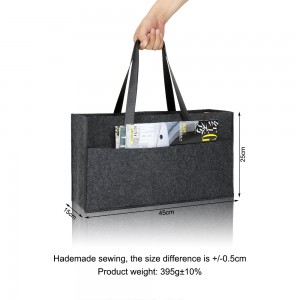The allure of felt handbags goes beyond their stylish appearance; it lies in the intricate craftsmanship that goes into creating each piece. From the sourcing of materials to the final stitching, every step in the production process is a labor of love, resulting in handbags that are not only functional but also works of art.
The journey of a felt handbag begins with the selection of high – quality materials. For natural felt handbags, wool is a popular choice. The wool is carefully sourced, often from ethical and sustainable farms, to ensure that it meets the highest standards of quality. Once the wool is obtained, it undergoes a process called felting. This can be done through wet felting, where the wool is soaked in hot water and agitated to cause the fibers to interlock, or through dry felting, which uses barbed needles to tangle the fibers together. Each method results in a unique texture and density, giving the felt its characteristic softness and durability.
After the felting process, the felt is cut and shaped according to the design of the handbag. Skilled artisans use templates and precision tools to ensure that each piece is cut accurately. This is a crucial step, as any errors in cutting can affect the overall structure and appearance of the handbag. Once the pieces are cut, they are ready to be assembled.
The assembly process involves stitching the felt pieces together. This can be done by hand or by machine, depending on the design and the level of detail required. Hand – stitching is often preferred for more intricate designs, as it allows for greater precision and control. Artisans use different types of stitches, such as the running stitch, backstitch, and blanket stitch, to create a strong and aesthetically pleasing seam. In addition to stitching, some felt handbags may also feature additional embellishments, such as embroidery, beading, or appliqué. These details are added by hand, further enhancing the uniqueness and beauty of the handbag.
The final touches on a felt handbag include adding hardware, such as zippers, buttons, and clasps, and lining the interior. The hardware is carefully selected to match the style and color of the handbag, while the lining provides an extra layer of protection and adds a touch of luxury. Once all these steps are completed, the felt handbag is inspected for quality and durability before being sent to market.
The craftsmanship that goes into making felt handbags is a testament to the skill and dedication of the artisans involved. Each handbag is a unique creation, with its own story to tell. By understanding the intricate process behind their creation, we can truly appreciate the value and beauty of these remarkable accessories.
Post time: May-06-2025

